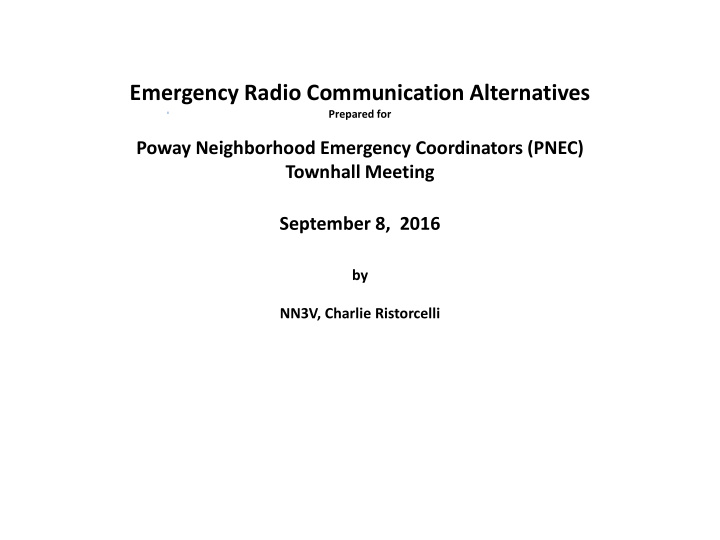



Emergency Radio Communication Alternatives Prepared for Poway Neighborhood Emergency Coordinators (PNEC) Townhall Meeting September 8, 2016 by NN3V, Charlie Ristorcelli
Agenda Why discuss radio communications • Personal Resources for radio communications • Family Radio Service (FRS) resources • Amateur (Ham) radio resources •
Why Discuss Radio Communications • Our society relies on communications for information – Broadcast radio and TV – Telephones • Land line • Cellular (they are radios) – Web services • Internet combines fiber with WiFi • Those communications rely on two prime resources – Electric power – Capacity of the communication system • Amount of traffic it can handle
What If? • Disaster strikes – Earthquake – Fire – Terrorist attack • Electric power fails – Quake destroys the grid – Fire destroys transmission lines • How do you know: – What? – Where? – How is my family? – Etc.
Disasters & Communications • August 2016 Louisiana Floods – Affected areas lost all power and services • No radio and TV news • Internet breakdown • Cellular system collapse • June 2016 Fire in Potrero area – Residents accused city leadership of failing to inform citizenry – Leadership admitted they had no public communications resources • Power loss • Telephones overwhelmed • Internet inoperative • 9/11 – Radio, TV, telephone, internet service in NYC completely disrupted • Remained that way for 2 weeks
Personal Impact of Disasters • Uncertainty about cause of calamity – Leadership affected by inability to guide response • Lessened ability to respond effectively – Safety – First aid • Family disruption – Inability to communicate to family members – Inability to know family situation
History Lesson • Every major disaster results in large loss of communications infrastructure – Loss of commercial infrastructure • Power • Internet • Phone service • Ham Radio: “The Communication System That Never Fails” – Totally independent of commercial infrastructure – Worldwide communications capability – Fully organized and trained • Emergency Responders (CERT, etc.) Health and welfare – – Worldwide organization • National and international • Ham VOLUNTEERS assist communities in need.
Family Disaster Communication Preparedness Two Way Radios • Family Radio Service (FRS) • Advantages – Inexpensive – No license required – 14 channels to choose from – Shared communication with GMRS radios • Disadvantages – Handheld only – 1 Mile Range
Family Disaster Communication Preparedness Two Way Radios General Mobile Radio Service(GMRS) – Advantages • Inexpensive (Much more easy to find) • Range of 2-5 miles (varies with terrain) • Base station or mobile • Boost signal with external antennas or repeaters – Disadvantages • Requires a license (one per family) – Intended for family use – Some business licenses are grandfathered – Range – better than FRS but still limited
Amateur (Ham) Radio • What? • How? • Where? • Local resources
Amateur Radio • Federally Licensed Service – Must have amateur radio license • Worldwide Communications – State of the art equipment – Ham operators establish infrastructure free systems • World famous disaster communications resource – Continuous operation & experience – Distributed capabilities – Nationally organized for disaster response
Poway Ham Resources Local ham volunteer operators part of: • – Radio Amateur Communication Emergency Service (RACES) • Federally charged with law and order communication backup – Amateur Radio Emergency Service (ARES) • National health and welfare communications assistance – Community Emergency Response Team (CERT) • Operate under auspices of Fire Department 50+ local ham radio operators • – 23 participate in Poway Amateur Radio Society (PARS) • Poway Amateur Communications Team (PACT) • Ham operator volunteers who practice disaster communication response Poway City Emergency Operations Center (EOC) • – Official city team that coordinates emergency response in Poway – EOC now equipped with amateur radio equipment to support all ham radio emergency communications volunteer effort
Poway Neighborhood Emergency Coordinators & Amateur Radio Effort to accelerate dissemination of emergency response information • within Poway – What, where, how, why, etc. – Get information disseminated even if commercial infrastructure collapses – Information generated with close association to City of Poway EOC Partnership between PNEC local coordinators & volunteer ham radio • operators – Ham radio volunteers able to respond to emergency will be communications resource – Information to and from EOC will reach ham operators – PNEC neighborhood coordinators can associate with ham radio volunteers Disseminate health and welfare information • Clarify local conditions • Assist in emergency recovery •
Recommend
More recommend